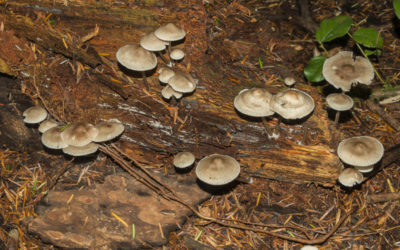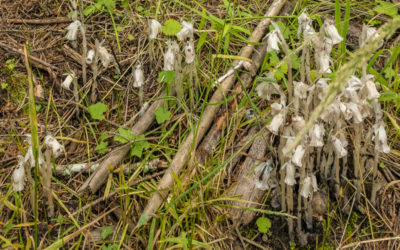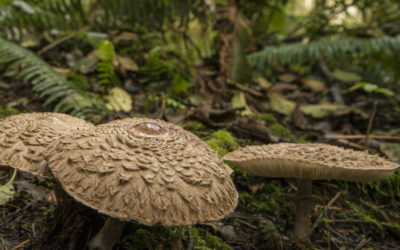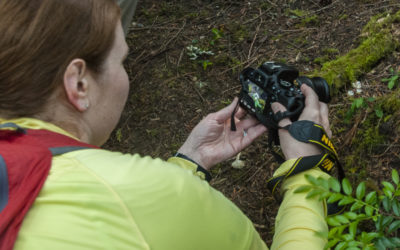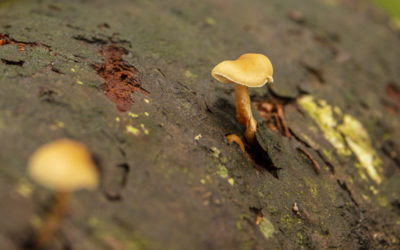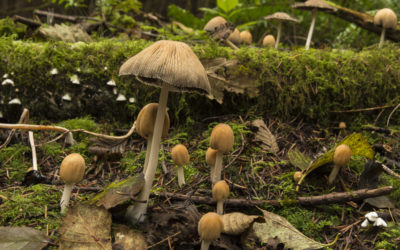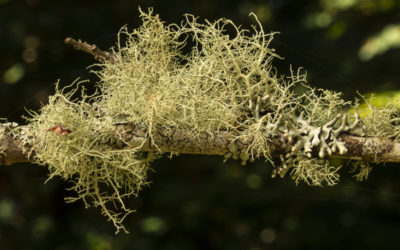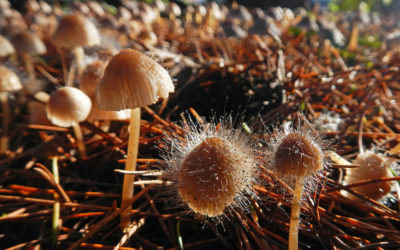THE YELLOW-SPOTTED MILLIPEDE
by Catherine Whalen, Autumn 2019
A couple of yellow-spotted millipedes spotted in North Kitsap Heritage Park in May. Photo by John F. Williams
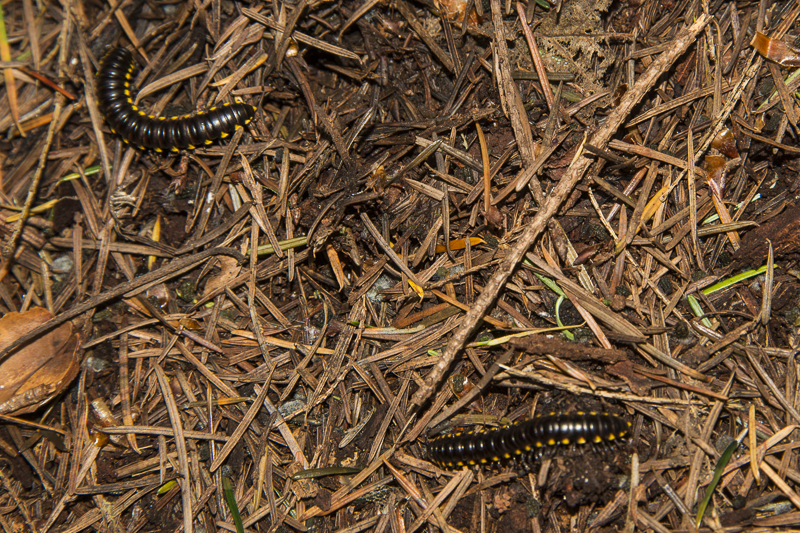
A couple of yellow-spotted millipedes spotted in North Kitsap Heritage Park in May. Photo by John F. Williams
THE YELLOW-SPOTTED MILLIPEDE
By Catherine Whalen, Autumn 2019
Before heading out on your next mushroom foray or walk in the woods, remind yourself that we share the forest with some remarkable species that have potentially toxic defense mechanisms. One of these wondrous animals is the yellow-spotted millipede, Harpaphe haydeniana. Other common names for this species are almond-scented millipede, cyanide millipede, and night train millipede. Belonging to the arthropod family, these beautiful creatures are plentiful in moist forests along the Pacific coast, from Southeastern Alaska to California.
Yellow-spotted millipede in action. Video by Catherine Whalen
yellow and black—stand well back!
Yellow-spotted millipedes are black with yellow-tipped keels (extensions on both sides of each segment), and reach up to two inches in length at maturity. Their black and yellow color combination signals danger and/or toxicity, and in this case it’s not a bluff! Harpaphe haydeniana coils up and secretes hydrogen cyanide when threatened. In general, while this amount of hydrogen cyanide is not deadly to humans, eye, mouth or nose contact with this specie’s toxin can result in severe or painful reactions. Areas exposed to the toxin should be flushed with clean water or saline and the affected person should be examined by a physician immediately. The toxin may also leave a dark stain on the skin for up to several months and can cause severe skin irritation in sensitive individuals. With that in mind, it’s prudent to keep children and pets from touching this species and to wear gloves if you need to handle one.
Although most millipede species are harmless, small dogs are especially susceptible to injury from this one given their curiosity and desire to dig up the almond-scented creatures. Millipedes usually secrete their toxins at the beginning stages of an attack, so if you see that your dog has been sniffing one, assume that the toxin may have already been released onto your pet. If toxin should get into your dog’s eye, wash it out with water or saline immediately, and contact your veterinarian as soon as possible. My small, energetic dog recently unearthed two of these millipedes. Although my dog had minimal contact with them, she received a dose of the toxin in her eye. The results were a painful watering eye that could not be held open, severe inflammation of the eyelids and white of the eye, and lethargy. After confirming there were no scratches or punctures present in the eye, the veterinarian prescribed a steroidal ointment that alleviated the symptoms within a few days. Other accounts of dog or cat interactions with yellow-spotted millipedes describe severe symptoms such as ulcerations, sickness and lethargy. These occurred after pets had taken a millipede into their mouths, and veterinary intervention was required. Fortunately, these types of injuries do not usually cause permanent damage if symptoms are treated promptly and properly.

Photo by Catherine Whalen
Interestingly, scientists have determined that these cyanide-producing millipedes are immune to their own secretions because of their ability to convert the toxin to harmless chemicals. Small wild creatures, e.g., insects, birds, and small mammals such as shrews, are among the unfortunate who don’t survive their brightly-colored millipede meal. Yellow-spotted millipedes’ toxicity makes them nearly immune to predation.
partners in grime
The fact that the yellow-spotted millipede has few predators is great for them and great for the environment. Their importance in the forest ecosystem cannot be overstated. The feeding activity of millipedes is vital for the redistribution of organic matter in the forest ecosystem. Due to their lack of predation, a large population of yellow-spotted millipedes can consume vast amounts of food. Their favorite food is leaf litter, primarily needles from fir and spruce trees. Harpaphe haydeniana is the principal shredder throughout Northwest forests and is one of the most critical links in the entire soil food web. This one species can eat up to 50 percent of the dead leaves and conifer needles on the forest floor.
Yellow-spotted millipede in action. Video by John F. Williams
In addition to being supreme shredders and munching their way through the forest floor, yellow-spotted millipedes have an interesting partner in the cycle of breaking up plant material: fungi! Microscopic fungi live in the hindgut of millipedes, helping the millipede break down plant material while absorbing the nutrients from the hindgut. This symbiotic relationship benefits both millipedes and fungi. As it eats, the millipede extracts some nutrients from its diet of forest litter. As it chomps its way through the forest, it produces fecal pellets of undigested nutrients covered with intestinal mucus. Microscopic fungi immediately grow upon the surface of fecal pellets, which may then be re-eaten by the millipede, providing the millipede additional nutrients from the fungi. The entire process of shredding, filtering and re-shredding dead leaves into smaller and smaller bits—along with supporting the growth of microscopic fungi—increases the availability of the leaf litter’s nutrients by 40,000-fold. In addition, decaying millipede remains provide a valuable resource for fungal populations. Through these remarkable processes, nutrients are used to the maximum benefit, decaying matter is recycled back into the soil, and nothing is wasted.
a healthy ecosystem
The forest understory is host to a vast variety of organisms, both plant and animal, all functioning in their particular roles in the soil ecosystem. Soil plays a crucial role in the carbon cycle by storing carbon and helping to mitigate climate change. Every living thing, even the tiniest creatures like millipedes and their fungal partners, contribute to the overall health of soil and our global ecosystem. So, on your next walk through our beautiful Pacific Northwest forests, consider the complex web of life and how the beautiful yellow-spotted millipede, as it eats its way across the forest floor, is just doing its job to keep our planet healthy.
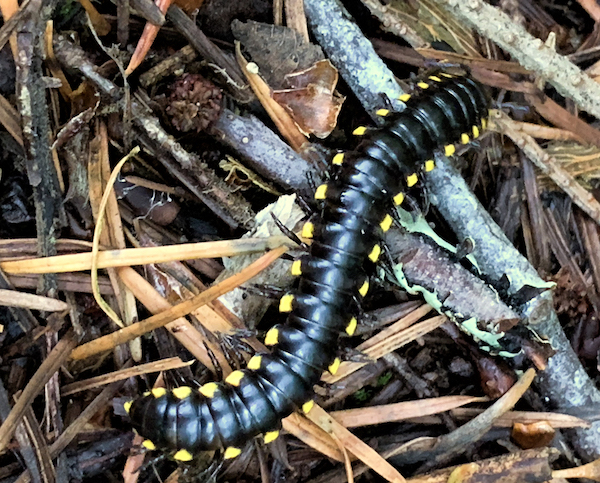
Photo by Catherine Whalen

Catherine Whalen has been passionate about science and the natural world since she was in pre-school. As an artist and photographer, she indulges her passion for nature by creating photographic Nature Mandalas and taking portraits of the flora and fauna of Kitsap and Olympic Peninsulas. Her favorite subjects are anything intertidal. She resides in Bremerton with two senior rescue dogs. Catherine’s Nature Mandalas can be viewed at: https://www.soulful.life/about-our-nature-mandalas. She can be contacted at: Catherine@Soulful.Life
Table of Contents, Issue #5, Autumn 2019
Think Like a Mushroom
by David Ansley, Autumn 2019 Photos by John F. Williams, except where notedPhoto by John F. WilliamsBy David Ansley, Autumn 2019 Photos & video by John F. Williams except where notedMushrooms? I don’t know how I missed them. I grew up deep in a second-growth...
Ghost Plant
AN UNDERSTORY THIEF by Adelia E. Ritchie, Autumn 2019 Photos by John F. Williams except where notedAN UNDERSTORY THIEF by Adelia E. Ritchie, Autumn 2019 Indian Pipes “Stop,” I said. “Indian Pipes.” Ghostly white, tiny vampires reaching up from moist loam...
Mushroom Poetry
by Mahathi Mangipudi, Autumn 2019 Photos by John F. Williams, except where notedBy Mahathi Mangipudi Autumn 2019 Photos by John F. Williams except where notedEquinox ~ s p r i n g ~fragile buds twist and turn,bloom under warm rays of pastel goldnutrients taken from...
Foto Tour 1
Showcase of Participant Photos from June 4, 2019 Showcase of Participant Photos from June 4, 2019 On June 4, 2019, WSU Extension in Kitsap County hosted a Forest Foto Expedition led by John F. Williams. We met at Newberry Hill Heritage Park in Silverdale. A park...
Mushroom Photo Essay
by John F. Williams, Autumn 2019 Photos & video by John F. Williams except where notedBy John F. Williams, Autumn 2019 Photos & video by John F. Williams except where notedintroduction This issue contains a couple of very informative articles about mushrooms...
Survival of Our Woods
DEPENDS ON MUSHROOMS by Olaf K. Ribeiro, Autumn 2019DEPENDS ON MUSHROOMS by Olaf K. Ribeiro, Autumn 2019 Have you ever wondered about the mushrooms you see in the woods? Actually, there is much more to mushrooms than the colorful forms that so delight us during our...
Lichens
by Sara and Thomas Noland, Autumn 2019Photo by John F. Williamsby Sara and Thomas Noland, Autumn 2019 In the fantastical world of fungus, it’s hard to stand out. But the lichens have managed to do just that. You probably see lichens every day, whether in your yard,...
More Mushrooms: Another Photo Essay
by Catherine Whalen, Autumn 2019 Photos & video by Catherine Whalen except where notedBy Catherine Whalen, Autumn 2019 Photos & video by Catherine Whalen except where notedart imitates lifeI found the above mushroom in my front yard one afternoon and it...
PLEASE HELP SUPPORT
SALISH MAGAZINE
DONATE
Salish Magazine contains no advertising and is free. Your donation is one big way you can help us inspire people with stories about things that they can see outdoors in our Salish Sea region.
We also don't advertise Salish Magazine, so please spread the word of this online resource to your friends and colleagues.
Thanks so much for your interest and your support.
We also don't advertise Salish Magazine, so please spread the word of this online resource to your friends and colleagues.
Thanks so much for your interest and your support.
FIND OUT MORE
http://www.ccffa-oswa.org/NWWoodlands/soil-water/2001summer-invertibrates.pdf
https://www.srs.fs.usda.gov/pubs/7603
https://irma.nps.gov/DataStore/DownloadFile/545601
https://open.library.ubc.ca/cIRcle/collections/ubctheses/24/items/1.0072616
https://www.nrs.fs.fed.us/pubs/jrnl/2005/nc_2005_lilleskov_001.pdf
http://bioweb.uwlax.edu/bio203/f2013/crain_alex/interactions.htm
http://www.angelfire.com/wizard/kimbrough/Textbook/TrichomycetesandAmbrosi_blue.htm
https://www.latimes.com/archives/la-xpm-2004-nov-30-os-field30-story.html

